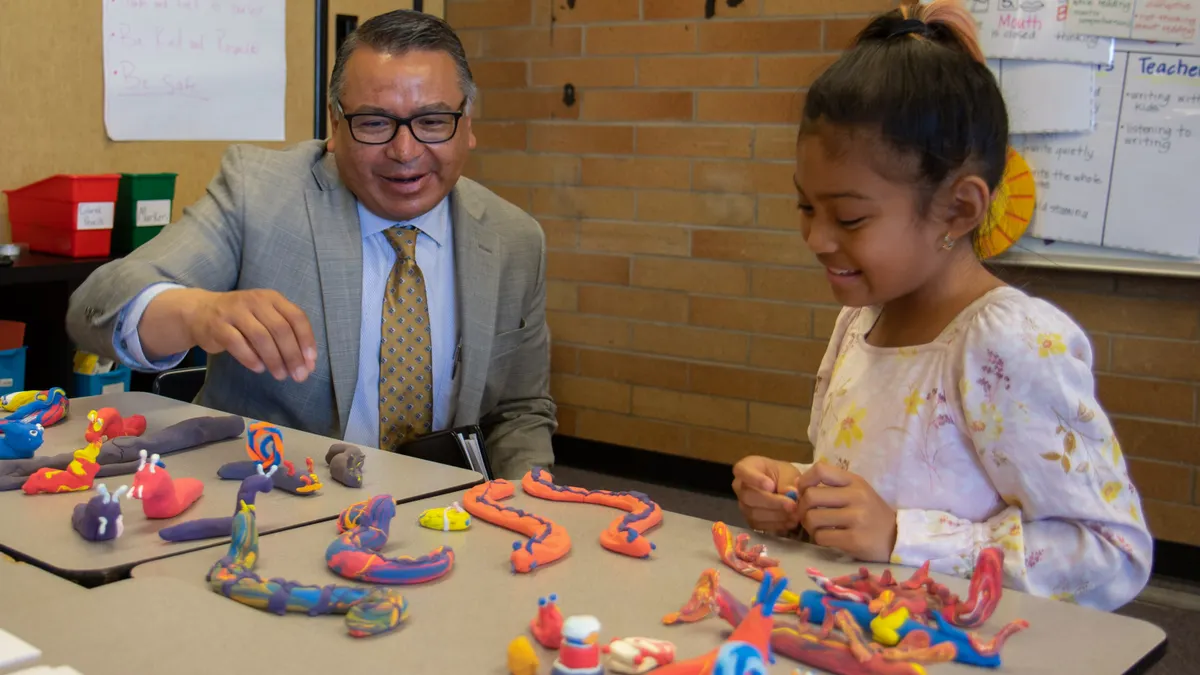WASHINGTON — The sharp increase in chronic absenteeism over the past few years has led schools and their partners to use an abundance of strategies — including messaging, individual interventions and data analysis — to get students back into the classroom and engaged in learning.
While many of the supports are working and attendance is creeping back toward pre-pandemic levels in many schools, there are still too many students missing school, say educators and attendance experts.
On Wednesday, federal, state and local education leaders gathered at the Eisenhower Executive Office Building near the White House for an Every Day Counts Summit to encourage families, community organizations, local elected officials, businesses, faith leaders, pediatricians and others to spread the word about the importance of school attendance.
"Schools cannot do this work alone, and they shouldn't have to," said Rhode Island Gov. Daniel McKee, speaking to a crowd of about 100. "Coming out of the pandemic, the workload is a lot, and we need to make sure we all jump in and help."
McKee said Rhode Island is taking several approaches on this front, including engaging with educators, municipal leaders, elected officials, judges and more. The state's Learn 365 RI initiative aims to shift learning from the traditional 180-day model to one that provides year-round educational and career readiness opportunities.
A statewide awareness campaign with the slogan that it's "cool to be in school" features messages from influencers, incentives for strong attendance, and resources for schools.
As a result, over 90% of schools in the state are reporting fewer chronically absent students year-over-year, and nearly one-third of schools have reduced chronic absenteeism by 10 percentage points compared to the same time last year, McKee said. Chronic absenteeism is when a student misses 10% or more of school due to any reason.
The state also has an online dashboard showing school-by-school attendance with data updated daily. "Anybody who visits my office, I don't care what department they're from or what business world they come from, they see the attendance dashboard," McKee said.
Katie Jenner, secretary of education for Indiana, also showed off her state's attendance dashboard, which is integrated into publicly-accessible data on school performance data points and other statistics.
In Indiana, educators are noticing the highest rates of absenteeism are in K-2 and then in grades 9-12. Overall, 19.3% of students missed about one month of school, said Jenner, who was also speaking at the event remotely.
"A lot of our conversation has been around: How do we make the four years of high school more valuable for students?" she said.
'We are listening'
Educators at the local level also shared the various strategies they use to boost attendance and engagement.
Virginia's Richmond Public Schools moved away from punitive approaches to absenteeism to a model that removes barriers to individual attendance challenges, as well as one that increases positive school connections, said Shadae Harris, the district's chief engagement officer.
Richmond Public Schools has put building relationships at the center of its work and has prioritized listening to families' needs. For example, the district has worked with partners to help find stable housing for families, Harris said.
"We are listening to the hopes, the dreams, the wants of our families, and we're designing the system to meet those needs," Harris said.
Tyree Pollard, director of whole child community partnerships in Ohio's Columbus City Schools, talked about the team approach the district and schools use to tackle absences. Those involved hold regular meetings to talk about challenges and how to implement student supports. Every school has an attendance goal, which helps create ownership toward those efforts, he said.
The district also solicited support from community members, such as recreation center managers and pediatricians, in helping to emphasize to students and families the importance of school attendance.
"Now we're moving in unison, and that's what it takes to attack this monster, because it's a team effort," Pollard said.

Isaiah Figueroa, a 16-year-old student from the Bronx, New York, had struggled with attendance. But after getting support from Children's Aid, a nonprofit that supports low-income children and families in New York City, he has increased his school attendance rate from 21% to 92%.
He told attendees that resources provided by a social worker, such as suggestions for apps to help him cope with stress, made a positive difference. "Being able to access support whenever I needed it… really honestly helped me," Figueroa said.
The whys matter
Wednesday's event was accompanied by a White House announcement that asked all states, cities and towns, and schools to cultivate a “culture of attendance” and asserted that students need to be in school.
The announcement also included resources and suggestions for best practices such as home visits, so families and educators can collaborate on solutions for attendance barriers or just to build relationships.
Additionally, the U.S. Department of Education is providing resources to increase attendance and engagement, and to help schools find the root causes of chronic absenteeism and explore interventions.
U.S. Education Secretary Miguel Cardona said chronic absenteeism is a symptom of other problems. When educators ask a student why they are chronically absent, they might hear that the student needs to work to support their family, needs to help care for younger siblings or can't find transportation to school.
"They'll tell you a reason why they're struggling, and these whys — they matter," Cardona said.
"This is a very crucial moment for academic recovery, so we need all hands on deck to make sure that we're getting students fully engaged, and re-engaged in some cases, to attend school every day," he said.
Correction: In a previous version of this article, Gov. Daniel McKee's location was misidentified. He attended the event in-person.


















